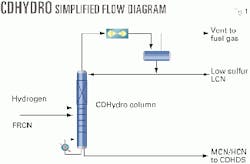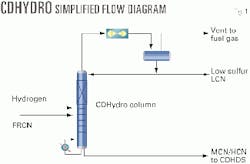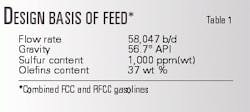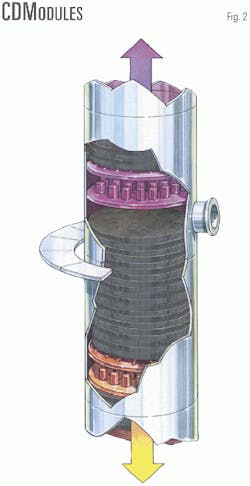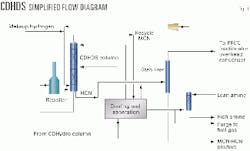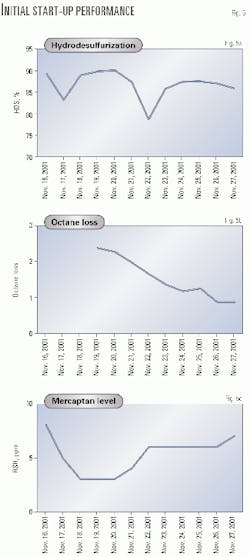Irving Oil Ltd.'s recent refinery upgrade project in Saint John, NB, commercialized CDTech's CDHydro and CDHDS technologies for selective desulfurization of FCC gasoline.
The upgrade project significantly increased the refinery's production of low-sulfur gasoline ahead of scheduled Canadian regulations.
It took less than 2 years from technology selection to complete the gasoline desulfurization project. Irving Oil and CDTech accomplished the start-up and acceptance of the new units in less than 1 month.
Background
In 1999, Canada approved new regulations to provide cleaner air by placing limitations on the sulfur content of gasoline.
Sulfur levels in gasoline average 360 ppm in Canada, among the highest in the world. Levels in Ontario averaged 530 ppm in 1997, but levels in other regions of Canada averaged between 260 and 290 ppm. Irving Oil has been a producer of less than l50-ppm gasoline for some time, however.
The new regulations will bring Canadian gasoline sulfur levels in line with those in California, Japan, and the European Union. They will reduce the sulfur content in gasoline to an average level of 30 ppm with a maximum of 80 ppm. This is a 90% reduction from average levels today.
To reduce the impact on industry, the sulfur requirement will be ramped downwards in phases. In 2002, Canada will lower the level to an average of 150 ppm with a maximum of 200 ppm. The 30-ppm level will come into effect in 2005.
Irving's program
In 1998, Irving Oil began a refinery upgrade project that included a 70,000-b/sd residue fluid catalytic cracking unit (RFCCU) to supplement the gasoline produced by the existing vacuum gas oil (VGO) FCCU.
The King of Cats project, as it was called, was the largest refinery upgrade project in North America in the past decade (OGJ, Mar. 27, 2000, p. 45). This project was Irving Oil's first step towards producing fuels to meet the 2005 standards ahead of schedule, by 2002.
During development of the King of Cats project, Irving Oil positioned itself for the future 30-ppm specification by evaluating technologies for desulfurization of FCC gasoline. Irving chose the combination of CDHydro/CDHDS technologies available from CDTech based upon performance and capital cost.
Irving Oil and CDTech executed the project in record time. The refinery awarded CDTech the technology selection and held the project kick-off meeting in January 1999; basic engineering was completed mid June 1999; start-up began on Nov. 11, 2000; and Irving accepted the CDHydro/CDHDS unit on Dec. 7, 2000.
Process overview
In the CDHydro/CDHDS processing scheme at the Saint John refinery, the FCC and RFCC gasolines are combined as full-range catalytic naphtha (FRCN) and fed to the CDHydro column. The column fractionates this naphtha to produce light catalytic naphtha (LCN) and medium plus heavy catalytic naphtha (MCN/HCN; Fig. 1).
Table 1 lists the properties of this FRCN.
The top of the column holds a bed of nickel catalyst contained in structured packing that facilitates simultaneous reaction and distillation. Fig. 2 is a cutaway view of the column, showing the catalyst bed. The structured packing has very high distillation efficiency, exceeding that of conventional trays.
Hydrogen, available at 84% purity at the refinery, is fed to the column below the catalyst bed where it mixes with the vapor and flows up through the catalyst bed. In the bed, the liquid and vapor phases are in counter-current contact and react according to the reaction in the accompanying box.
The reaction goes essentially to completion, converting virtually all of the mercaptans in the light fraction of the FRCN into high boiling point sulfides that are removed with the MCN/HCN bottoms product. The LCN product is a sweet gasoline with very low sulfur content.
The bottoms of the CDHydro column is preheated and fed to the CDHDS column as shown in Fig. 3. The CDHDS column fractionates the feed in beds of structured packing containing CoMo catalyst to produce a medium catalytic naphtha (MCN) distillate and a heavy catalytic naphtha (HCN) bottoms stream.
A fired heater reboils the bottoms products, and hydrogen is added at the bottom, below the catalyst beds.
The sulfur in the feed is converted to hydrogen sulfide (H2S), which is stripped overhead along with the MCN vapor. The MCN vapor is condensed to provide reflux as well as low-sulfur distillate.
The vapor vented from the reflux drum contains the remaining hydrogen, H2S, and other light components from the makeup hydrogen. This stream goes to the amine absorber, which removes H2S, and then to the recycle compressor before returning to the CDHDS column.
The cooled MCN is sent to the stripper along with the HCN, where hydrogen and light makeup hydrogen components are stripped overhead to control the vapor pressure of the product. Low sulfur (sweet) MCN/HCN is sent to storage for final gasoline product blending. No further treatment of the stripper bottoms is required for sulfur or mercaptan reduction.
Conventional reactors
In conventional fixed-bed reactors, there is a tendency for H2S to combine with olefins to form mercaptans before the product leaves the reactor and to continue this reaction until the reactor effluent is cooled enough to stop the reaction.
In some cases, this effect can result in a product with more than 200 ppm of mercaptans in spite of a reduction of the other sulfur compounds to only a few ppm.
The mercaptans that are formed from the olefins have a much higher boiling point than the olefins from which they were formed. As a result, in the CDHDS column, the mercaptans tend to be separated from the distillate by fractionation.
This effect keeps the mercaptans bottled up in the column where they are again separated into H2S and hydrocarbon by the hydrodesulfurization (HDS) catalyst. Therefore, a greater fraction of the sulfur leaves the CDHDS overhead as H2S instead of as mercaptans than in a conventional fixed-bed reactor.
The overhead vapor is quickly cooled in the condenser, thus quenching the reaction and stopping the formation of additional mercaptans. Meanwhile, the HCN is produced at the bottom of the CDHDS column where the H2S and olefin levels are much lower than at the top of the column; hence, it contains virtually no mercaptans.
Therefore, the mercaptan content of the CDHDS bottoms product is much lower than the corresponding conventional fixed-bed HDS reactor product.
Testing; catalyst loading
The construction contractor and Irving Oil personnel divided the plant into numerous test systems to allow tracking of construction progress and hydrostatic testing and flushing-blowing of systems. CDTech provided an experienced operations expert to assist Irving personnel with precommissioning activities.
Most of the testing and flushing of the unit systems was done with water. Special care was taken with lines that were tied into the column to protect the catalyst and distributors from extraneous materials. Following catalyst loading, a maintenance crew blinded the column and put it under a nitrogen blanket to protect its internals from ingress of extraneous materials during the final stages of construction and precommissioning.
The catalyst structure is physically similar to other commercial structured packing. The CDModules (the structured packing containing catalyst) are easily handled and loaded into the column in a specified pattern to maximize catalyst loading density.
Each bed of catalyst contains multiple levels (or layers) of modules arranged according to a predetermined loading diagram onto a catalyst support grid (Fig. 2).
Special perimeter structures are provided to fit the curvature of the tower wall. The arrangement optimizes the overall catalyst bed vapor-liquid contact efficiency for simultaneous reaction and fractionation.
The CDModules for the CDHydro/CDHDS unit were stored in a warehouse off site, out of the weather. As needed, the construction crew brought the modules containers to a staging area at the base of the columns. The crew then placed them in a loading basket, which was lifted by a crane to the loading platform.
There are loading manways at each catalyst bed on the columns between the catalyst support grid and the chimney-collector tray. The construction contractor's personnel provided the labor for loading the catalyst structure under the supervision of CDTech personnel.
Catalyst loading of the CDHDS column was completed in September. The refinery then put the tower under a nitrogen blanket, awaiting catalyst conditioning and start-up.
Operator training
In preparation for initial start-up of the unit, CDTech prepared a training manual based in part on its basic engineering package. Using this document as a reference, CDTech conducted a detailed training program for Irving's operating and technical personnel at the refinery.
The program covered such topics as normal operation and control, commissioning and start-up, shutdown and emergencies, safety and environmental issues, and analytical control. The company conducted the course in two parallel classes to accommodate the entire operations staff, which was already working a shift schedule.
The training took place less than 2 months before start-up, when most of the construction was complete, allowing the trainees to spend time after the course outside on the unit.
Initial start-up
Although the CDHydro/CDHDS unit was ready for start-up in October, Irving Oil diverted manpower to complete construction and precommissioning activities related to the new RFCCU. Since the unit could be bypassed initially by the RFCC and FCC gasoline streams, emphasis shifted to preparing the RFCCU for start-up.
As progress on the RFCCU neared completion, work shifted back to the gasoline desulfurization unit to have it ready for start-up soon after the RFCCU. The operators conditioned the CDHDS unit catalyst in early November and introduced feed to it on Nov. 11, 2000.
Fig. 4 shows the unit in the final stages of construction. The fired heater is in the foreground, and the first tower is the CDHDS column. The second tower is the CDHydro column. The new RFCCU is in the background.
In addition to precommissioning, training, and catalyst loading services, CDTech provided technical and analytical support around-the-clock during the commissioning and initial start-up of the plant.
The analytical support included on site laboratory equipment (total sulfur-nitrogen analyzer, speciated sulfur and hydrocarbon gas chromatographs, and bromine number/mercaptans titrator).
This support allowed the refinery laboratory to benefit from the experience of the CDTech team and develop consistent analytical practices. This information was important to the detailed analysis and comparison of plant operating data against commercial and pilot plant results.
Before introduction of RFCCU gasoline (debutanizer bottoms) feedstock to the CDHDS unit, the selective hydrogenation and hydrodesulfurization catalysts had to be activated, or conditioned.
The selective hydrogenation catalyst must be reduced in the presence of hydrogen at a minimum operating temperature. The reduction procedure consisted of first circulating a sweet hydrocarbon stream through the column at a mild temperature, increasing the temperature to a higher level, and injecting hydrogen to reduce the nickel catalyst.
As loaded, the fresh hydrodesulfurization catalyst was in an oxide form. In this form, the catalyst was not active for the desired HDS reactions. A thorough presulfiding was needed to convert the metal oxides into active substoichiometric sulfides.
Before presulfiding, the catalyst had to be dried to remove moisture absorbed from the atmosphere during handling and packaging into the structured packing. Drying was accomplished by circulating hot hydrocarbons through the column and injecting nitrogen to act as a sweeping gas to carry the moisture-laden vapor overhead.
The presulfiding procedure consisted of soaking the catalyst with hydrocarbons containing dimethyl disulfide and sulfiding at elevated temperatures. Once finished, the unit was kept under nitrogen pressure until reactive feedstock was available.
Full range RFCCU gasoline from the gas concentration section debutanizer bottoms was introduced to the unit on Nov. 11, 2000, at about 50% of design rate. The feed rate to the CDHydro/CDHDS unit was later raised to about 85% of design rate with the introduction of the FCC gasoline. The design capacity was not attained due to feedstock unavailability.
The start-up of the CDHydro and CDHDS columns was like a start-up of conventional distillation columns with one exception: The additional hydrogen feeds (for reaction) are not started until column reflux is well established.
The unit start-up was uneventful and no problems were encountered. Usual issues like controller tuning, sampling, and developing a "feel" for the operation presented the main challenge during the initial few days of operation.
The new unit directed product to tankage shortly after start-up.
Unit performance
During initial operation (Nov. 11-Dec. 7), operators checked the unit performance at various operating conditions including low, mild, and high levels of desulfurization. These actions generated an operating envelope for the unit and checked the unit for any operating constraints. No constraints were found during these operations.
Low-severity operation (maximizing octane retention at moderate desulfurization levels) was the most common operation during the initial start-up period. Tests done at higher severity operation determined how low a sulfur product could be produced and the associated octane penalty.
Since initial start-up, the unit has operated steadily at design throughput, producing on-specification product.
There has been one major upset thus far, resulting from a severe ice storm that shut down the entire refinery in late December. Although the unit experienced a sudden shutdown, the results since the restart indicate no loss of performance or catalyst activity.
The unit operation and control follows conventional distillation practices with few exceptions related to the reaction performance and catalyst activity maintenance. Fig. 5a shows the operating data during the initial start-up period of operation.
The HDS conversion across the unit was high during initial operations, much greater than the design level of 68%. The HDS level was increased during the high-severity test period at the request of Irving to determine the flexibility of the unit and the range of operation for planning, blending, and production purposes.
This was accomplished by increasing the pressure of the CDHDS column and varying the LCN draw from the CDHydro column. A lower CDHDS pressure operation coupled with a high CDHydro sidedraw rate resulted in less severe HDS conditions yielding slightly lower HDS conversion but higher octane retention as shown by the reduction in octane loss.
In general, the overall HDS conversion across the entire unit has been maintained in the mid 80% range during initial operation at the request of the Irving planning group. Average octane loss (R+M/2) has been about 1 octane number during this time period (Fig. 5b).
Since initial start-up, the unit has been operating steadily at design throughput producing a product meeting desulfurization and octane retention specifications.
The product has remained relatively sweet, as shown by the weighted mercaptan level in Fig. 5c.
Other issues
Feedback from refiners has highlighted a concern about the need to replace the unique structured packing catalyst system on short notice.
Although the catalyst itself is robust and appears to have a long life, there remains a low probability that emergency conditions, such as severe weather conditions, may cause enough unit damage to warrant catalyst replacement. As a result, CDTech has committed to keep a stand-by supply of the catalyst in inventory, available on emergency notice.
Another item of concern for refiners is the time required for replacement of the catalyst. Although the normal occurrence and time required would be within the period available in a typical FCC major turnaround, an emergency replacement would necessitate a much faster rate than demonstrated during the initial catalyst loading at the two existing commercial units.
To address this issue, CDTech has formed an alliance with Cat Tech, a catalyst handling company based in Pasadena, Tex.
The unloading and reloading of the structured packing modules will be significantly improved by changing the design of the CDModules to make them easier and faster to load. These improvements will be used for the catalyst loading at Texaco Inc.'s Pembroke new CDHydro/ CDHDS installation later this year.
Based on a presentation at the NPRA (National Petrochemical & Refiners Association) Annual Meeting, New Orleans, Mar. 18-20, 2001.
The authors
Rob Gardner is the manager of refining technology for Irving Oil in Saint John, NB, Canada. He has more than 24 years' experience in the refining industry both in the UK and Canada and has held senior positions in operations, maintenance, project management, and technical areas. Gardner holds a chemical engineering degree from the University of Birmingham in the UK and is a registered professional engineer in Alberta.
Eric A. Schwarz is customer and technical service manager at CDTech, Houston. He has more than 20 years' experience in the petroleum and refining industry. Before joining CDTech in 1988, he worked for Stone & Webster Inc., where he was involved in the start-up of several resid fluid catalytic cracking units. Schwarz began his career at Exxon Research & Engineering Co. He holds an undergraduate degree from Syracuse University, New York, and a graduate degree from Princeton University, NJ, both in chemical engineering.
Kerry L. Rock is a manager at CDTech, Houston, currently responsible for marketing process technologies to the refining and petrochemical industries. He has more than 25 years' experience in the oil and gas refining and petrochemical industries. He holds a BS and an MS in chemical engineering from the University of Houston.
